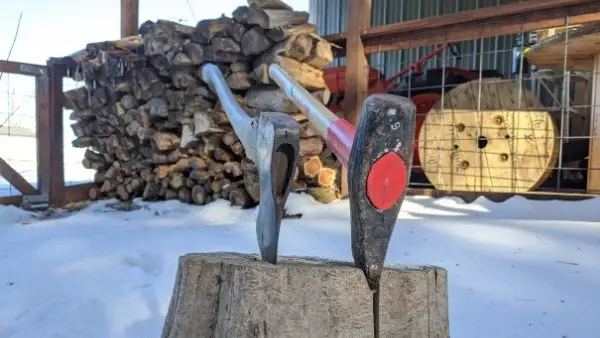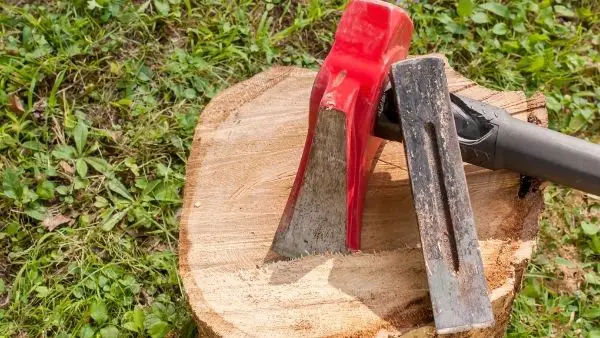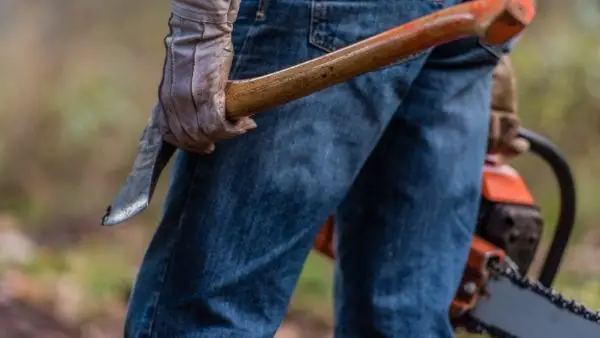As a self-sufficient homesteader, you are probably not going to the store to purchase overpriced split firewood for your wood burner or fireplace. You are most likely using what the land provides by chopping and splitting your own wood. This daily or weekly task can quickly become frustrating when you are constantly getting your axe stuck in the wood log.
The reason your axe is getting stuck in your wood log is because you are most likely using a chopping axe instead of a splitting maul. A splitting maul, weighing 6-8 lbs, is designed with a blunt and wide V-shaped head that drives parallel to the wood grain, causing the wood grains to split apart.
It’s easy to assume that all axes are created equal and any axe will cut wood if you have enough force behind it. With that mentality, you’re going to experience a lot of frustration, as well as sore back muscles. The rest of this article will give you the tools and techniques to split wood with ease.

How to Get Your Axe out of Wood?
Sometimes, even with the right tools, you still end up getting your axe stuck. Especially if you are working with grainy, knotty hardwoods. There are a couple techniques to help get you unstuck.
The first trick to getting your axe unstuck from a piece of wood is you can try lifting the handle and rocking it in an up and down motion. If you are lucky, this will shimmy the axe out. If not, the axe and log will move as one.

When this happens, some people will attempt to bring the stuck axe, along with the log, up over their head, and bring it down on top of the block. Don’t attempt this! There is too much of a risk of bringing that down on your head.
The next best thing to try is using a wedge and hammer. Place the wedge in between the axe and wood, knock it a few times with the hammer. You should be able to move the axe free, leaving the wedge in place of the axe.
What’s the Difference Between an Axe and a Maul?
Whether you are working with oak, beech, ash, or maple, determining whether you need an axe or a splitting maul comes down to what you are wanting to accomplish. The physical differences between the two may seem minuscule but has a direct result in how effective you will be in chopping or splitting your wood.
Chopping vs Splitting Wood
Chopping is when you take the sharp edge of your axe and solidly swing at the tree trunk or fallen log and start cutting, or chopping perpendicular or at a slight angle across the grain of the wood, and doing so as many times it takes you to reach the other side.
Chopping requires an axe with a sharp tip, followed by a thin blade and head that is lightweight. This Snow and Nealley Hudson Bay Axe from Amazon.com is a great all purpose axe that you will love to show off to your friends.
Splitting is the opposite; you are using your axe to split down in between the grains of the wood, forcing them apart.
Splitting wood requires a maul that is designed with a blunt tip, followed by a wide wedge blade that forces the wood grains apart by sheer force. The engineered design of this Intertool Steel Splitting Maul makes easy work of splitting firewood. You can find it on Amazon.com.
Swing Technique
Axes tend to weigh about 3-4lbs, making them great for chopping branches as high as eye level, as well as chopping downed trees at ankle level.
A maul, weighing 6-8lbs, is heaved above your head, using your center gravity to strike a heavy blow down through the wood, toward the ground.
Handle Length
The length of the handle can make a huge difference as well. Mauls tend to have a longer handle, so when you are splitting through the wood, the blade will drive down toward the ground or chopping block, instead of back toward your foot.
An axe handle is much shorter, making the repetitious chopping action a little less laborious for your arm and back muscles.
How Does a Splitting Wedge help?
If you are dealing with hardwood on the regular, then using a splitting wedge is going to help you tremendously. Splitting wedges weight about 5lbs and come in a couple different shapes, the standard two-way wedge or a diamond shape.
The diamond splitting wedge, or wood grenade, is designed to split the log into four pieces all at once. Which can allow you to move quickly through your large pile of unsplit logs.
The two-way splitting wedge is great for large diameter logs that are just too big to deal with when they are whole. It’s not uncommon to have one or more of each of these to always be ready to tackle any splitting job.
How to Use a Splitting Wedge with a Maul?
The other nice feature of a splitting maul is that, in combination with the heavy weight and the blunt end (opposite of the blade), it is essentially a glorified sledgehammer. Partner it with a wedge and you will be able to power through the toughest of wood logs.

If working with a diamond wedge, place the wedge in the center of the log, tap a couple time with the maul to get the tip stuck and standing straight up. Make sure that it is in there good, you don’t want it to tip while in mid-swing.
If working with a two-way wedge, place the wedge closer to the outside of the log, then apply the same tapping technique as with the diamond wedge to lodge it into the log.
Once the wedge is solidly placed, with the same body-centered swing as when splitting with the maul, drive the maul into the wedge. It may take a few swings to split the log, depending on how large and what type of wood it is.
Proper Technique for Splitting Wood with a Maul
Before you start swinging your maul, and to prevent injury, let’s go over a few techniques that will make this task a lot easier.
- Your stance for splitting wood is with your feet even and shoulder width apart, with a nice bend in your knees. This makes it easier to use all of your body weight in your swing. This also helps to take a lot of the lower back work out of your swing and allows your legs to support the blow.
- Line the maul blade up with the grain of the wood. Finding existing cracks in the wood can make the first few swings a lot easier.
- Place your dominant hand right underneath the head of the maul, and your other hand near the end of the handle. As you swing, your dominant hand will slide down to your other, directing the blade with as much force as you can muster.
- As the blade is about to hit, bend your knees and stick your butt out, like if you are doing a squat. This motion will add even more force and will save you loads of back pain and keep you splitting till the job is done.
Other Tips for Efficient Wood Splitting
Once you start getting more familiar with splitting wood, the process becomes very efficient. Here’s some further tips to help you get started:
- When working on larger diameter logs, it’s best to aim the maul, or wedge, halfway between the center and the outside of the log. The edges are the weak point of the wood and will be easier to split. Once you split the log once, it will continue to get easier to split into smaller pieces.
- Having an even, solid surface to split your wood on is going to keep it from rolling and prevent any trips to the emergency room.
- Keep your feet away from where the axe will be. That’s why a nice wide stance is best.
Bonus Tip: Place the logs inside of a tire. This prevents the split chunks from flying away and/or prevents the axe from going into your foot.
Living on a homestead is more than a full-time job, it’s what we live and breathe. If we are lucky we will be doing it for the rest of our lives. Learning proper wood splitting technique will, at the very least, make sure you never get your axe stuck in wood.
You can check out these resources for some additional tips:
https://www.awesomeaxes.com/how-to-split-wood/
https://www.themanual.com/outdoors/how-to-split-wood/
https://northernwoodlands.org/knots_and_bolts/maul_vs_axe







